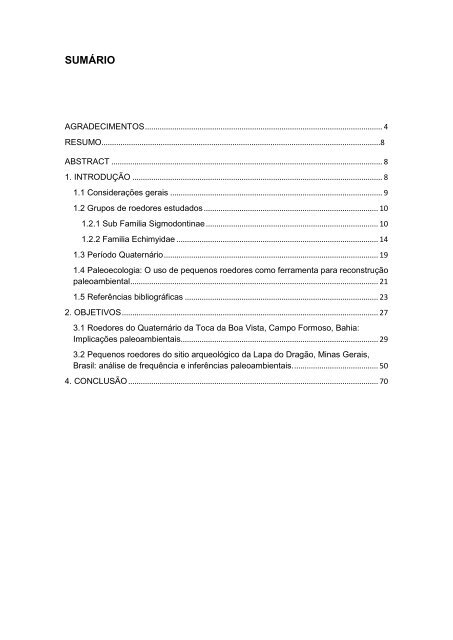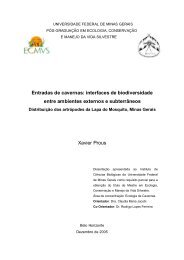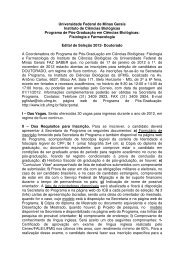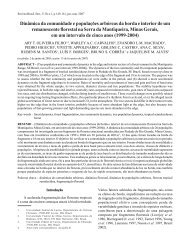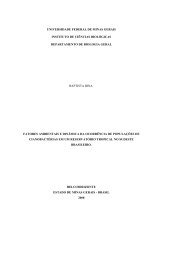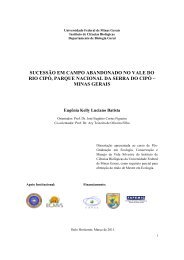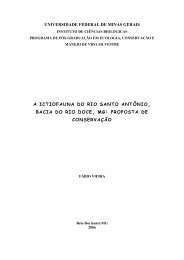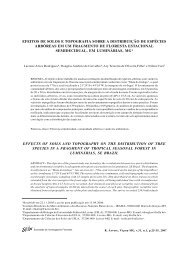Roedores do Quaternário de Minas Gerais e Bahia, Brasil - ICB ...
Roedores do Quaternário de Minas Gerais e Bahia, Brasil - ICB ...
Roedores do Quaternário de Minas Gerais e Bahia, Brasil - ICB ...
Create successful ePaper yourself
Turn your PDF publications into a flip-book with our unique Google optimized e-Paper software.
Islands of StabilityIt was in<strong>de</strong>ed completely chaotic in its unpredictability. Now, let’s read this nextparagraph slowly. It is important, as it creates a mental image that helps me un<strong>de</strong>rstandthe organization of the financial markets and the world economy. (emphasis mine)“To find out why [such unpredictability] should show up in their sandpile game,Bak and colleagues next played a trick with their computer. Imagine peering <strong>do</strong>wn on thepile from above, and coloring it in according to its steepness. Where it is relatively flatand stable, color it green; where steep and, in avalanche terms, ‘ready to go,’ color it red.What <strong>do</strong> you see? They found that at the outset the pile looked mostly green, but that, asthe pile grew, the green became infiltrated with ever more red. With more grains, thescattering of red danger spots grew until a <strong>de</strong>nse skeleton of instability ran through thepile.“Here then was a clue to its peculiar behavior: a grain falling on a red spotcan, by <strong>do</strong>mino-like action, cause sliding at other nearby red spots. If the red networkwas sparse, and all trouble spots were well isolated one from the other, then a single graincould have only limited repercussions. But when the red spots come to riddle the pile, theconsequences of the next grain become fiendishly unpredictable. It might trigger only afew tumblings, or it might instead set off a cataclysmic chain reaction involving millions.The sandpile seemed to have configured itself into a hypersensitive and peculiarlyunstable condition in which the next falling grain could trigger a response of any sizewhatsoever.”Fingers of InstabilitySo what happens in our game? “... after the pile evolves into a critical state, manygrains rest just on the verge of tumbling, and these grains link up into ‘fingers ofinstability’ of all possible lengths. While many are short, others slice through the pilefrom one end to the other. So the chain reaction triggered by a single grain might lead toan avalanche of any size whatsoever, <strong>de</strong>pending on whether that grain fell on a short,intermediate or long finger of instability.”Now, we come to a critical point in our discussion of the critical state. Again, readthis with the markets in mind (again, emphasis mine):“In this simplified setting of the sandpile, the power law also points to somethingelse: the surprising conclusion that even the greatest of events have no special orexceptional causes. After all, every avalanche large or small starts out the same way,when a single grain falls and makes the pile just slightly too steep at one point. Whatmakes one avalanche much larger than another has nothing to <strong>do</strong> with its original cause,and nothing to <strong>do</strong> with some special situation in the pile just before it starts. Rather, ithas to <strong>do</strong> with the perpetually unstable organization of the critical state, whichmakes it always possible for the next grain to trigger an avalanche of any size.”The Importance of Power Laws4/21/2006 3


